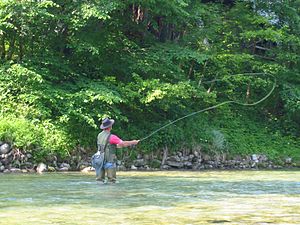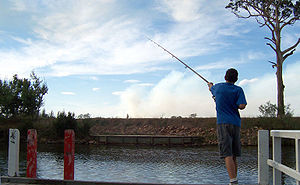Todd has some ideas when starting to fish or moving into a new area .
By Todd Wilkinson
Fishing is an activity that has been around for thousands of years. There are some cultures that base their diet entirely on things caught in lakes, rivers, and oceans. Fishing is more than just a popular way to obtain food. It is an extremely popular outdoor sport, although the word sport implies that rigorous and physically demanding work will be put into it. Fishing is more of a way for people to relax and unwind. There are a lot of people out there that do not take fishing too seriously. However, if you are a budding
fisherman that is looking to improve their game, then here are some methods you should put to good use, and some methods you should avoid like the plague.
The very first thing you need to figure out is what kind of fish there are in your area. There are plenty of budding fishermen that make the mistake of thinking that there is a universal bait or that all bodies of water have fish that like the same thing. You need to look into the area you live in and see what kind of fish you are more likely to catch in that area.
You can get most of this information from your county or state fish-and-game or wildlife folks. Or you can go online and get on some of your area's fishing sites and look at what is biting now.
After you learn what kind of fish are in your area, you need to consider what kind of bait you need to use to catch the fish that you want. Do not make the mistake that many first time fisherman do by assuming that a worm and a hook are all it takes. Granted, you can catch fish that way, people do it all the time, but you will not necessarily get the best fish possible with it. You need to learn what that fish likes to eat and use that for bait, or at least something close to it since certain types of baits are illegal.
One thing that you should not do is obsess over what kind of equipment you start out with. A standard rod and reel will suffice until you have developed your skills to the point of needing something better to work with. You need to also be sure that you have a good
tackle box to store your equipment in. Many fishermen make the mistake of putting all of their gear into the boat without any sense of organization. When you have a bite, this can waste time, so staying organized will help tremendously.
There are a lot of different methods of fishing out there. However, there are some methods that you should never try, both for your own safety and because they are illegal. Things like electro-fishing or trying to use explosives for fishing will only kill an unnecessary amount of fish, and land you with either a fine or in jail. Not to mention those methods are dangerous.
If you want to be a great fisherman, then the extra amount of research and work you put into it will pay off. All you have to do is put these tips to good use and you will be amazed at the number of fish you catch. You will never have to tell stories of the "one that got away."
 Image via WikipediaTod Huckabee demonstrates how to tie the knot he relies on every day on the water.
Image via WikipediaTod Huckabee demonstrates how to tie the knot he relies on every day on the water.

